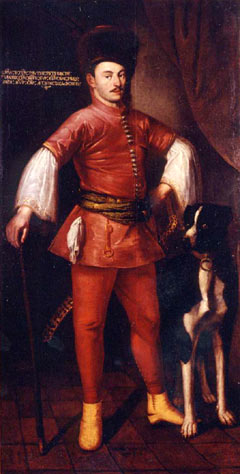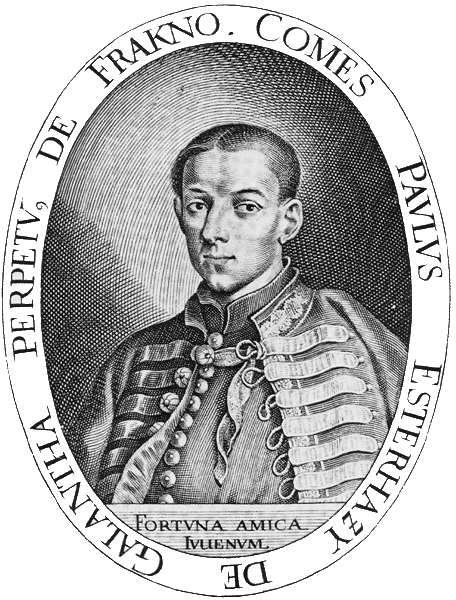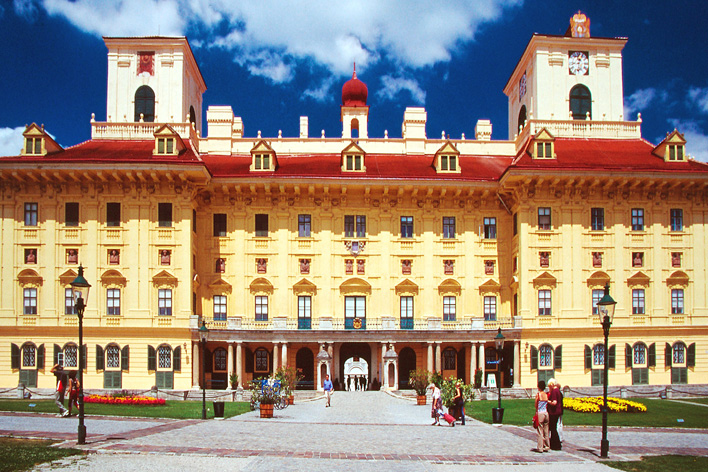<Back to Index>
- Physician and Theologian Thomas Erastus, 1524
- Poet Camilo de Almeida Pessanha, 1867
- Prince Esterházy of Galántha Pál I, 1635
PAGE SPONSOR


Paul I, Prince Esterházy of Galántha (full German name: Paul Fürst Esterházy von Galantha; full Hungarian name: galánthai herceg Esterházy Pál) (8 September 1635 – 26 March 1713) was the first Prince Esterházy of Galántha from 1687 to 1713, Palatine of the Kingdom of Hungary from 1681 to 1713, and an Imperial Field Marshal. Paul was also an accomplished poet, harpsichordist, and composer. He actively participated in various battles against the Ottoman Turks during the Fourth Austro - Turkish War (1663 – 1664) and the Great Turkish War (1662 – 1669). Paul is credited with establishing the wealth, power, and influence of the Princely House of Esterházy.
Born in Kismarton, Eisenstadt, Kingdom of Hungary, Paul was the third son of Nicholas, Count Esterházy of Galántha and his second wife Baroness Krisztina Nyáry of Bedegh. His father, Nicholas, bore the office of the Palatine of the Kingdom of Hungary.
Paul was raised in a deeply religious atmosphere and studied at Jesuit institutions in Graz and Nagyszombat. He displayed literary talents at an early age.
On 16 August 1652, Paul's elder brother Ladislas was killed in battle against the Turks at Vezekey. Paul succeeded Ladislas as Count Esterházy of Galántha and inherited the family's vast wealth and landholdings at the age of 17.
Paul began his military career as early as 1663, and opposed the Turks in the Battle of Saint Gotth ard under the leadership of Raimondo Montecuccoli. Paul served with distinction under Montecuccoli alongside Miklós Zrínyi. Paul served in the army with such distinction that he was appointed to the position of Field Marshal and Commander - in - chief of the Military Frontier of southern Hungary beginning in 1667 at the age of 30. While serving as a commander-in-chief, Paul defeated malcontents at Leutschau and Győr. Paul's troops were among the coalition that was raised for the Battle of Vienna in 1683. After the deliverance of Vienna from the Turks, Paul entered Buda in 1686 at the head of 20,000 men. Throughout his military career, Paul led the Hungarian side of the Habsburg army into battle against the Ottoman Turks a total of 16 times.
Paul throughout his life remained loyal to the Habsburgs, and therefore was not involved in the conspiracy of the Hungarian nobility in the 1670s. This loyalty was rewarded by the Habsburgs in 1681, when Paul was appointed to the position of Palatine of the Kingdom of Hungary. The wars with the Turks did not go unnoticed by the Esterházy family, because the advance of the Turks to Vienna devastated many of the family's lands and brought slaughter to many of the lands' residents.
In 1681, Paul was made a Knight of the Austrian Order of the Golden Fleece. On 8 December 1687, Leopold I, Holy Roman Emperor issued a princely diploma elevating Paul to a Prince of the Holy Roman Empire for his military successes against the Turks during the reconquest of Hungary and his loyalty to the House of Habsburg. The title of Prince was extended to his male descendants in 1712. On 9 December 1687, in his role as Palatine, Paul placed the Crown of Saint Stephen on the head of Archduke Joseph of Austria (later Joseph I, Holy Roman Emperor) as the first Habsburg hereditary king of Hungary. As an ally of the Habsburgs, Paul had as one of his principal concerns the recatholicization of those areas of Central Europe "infected" by Protestantism. Paul's loyalty was also demonstrated in his cooperation with the Habsburg court in the subversion of civiland religious liberties.
In 1703, Paul again fought with the Habsburgs in the wars with the Kuruc, armed anti - Habsburg Hungarian rebels in Royal Hungary.
From 1711 until his death, Paul served as Lord Lieutenant of Moson County.
Paul converted Schloss Esterházy in Eisenstadt from a medieval castle into a Baroque palace. Paul began his renovations of Schloss Esterházy in 1663. The additions made by Paul took nearly ten years to complete and gave the palace the façade it has retained to the present. Paul further extended, ornamented, and fortified Forchtenstein Castle with architect Domenico Carlone. At Forchtenstein Castle, Paul founded the Esterházy family's treasure house and created an extensive portrait gallery of Esterházy family ancestors.
Paul was an accomplished musical amateur, composer, and patron of the arts. He composed numerous cantatas, the most notable of which are Harmonia Caelestis. Harmonia Caelestis is a cycle of 55 sacred cantatas composed in the Baroque style published in Vienna in 1711. Paul was one of the chief compilers of the Trophaeum Domus Inclytae Estorationae.
Paul used his great wealth in the liberal patronage of art and literature. He founded the Esterházy private chapel, famous for its solo singers, chorus, and orchestra.
Paul was married twice. He married first to his niece Countess Ursula Esterházy of Galántha, daughter of his brother Count István Esterházy of Galántha and his wife Countess Erszébet Thurzó of Bethlenfalva, on 7 February 1652 in Eisenstadt. Paul's marriage to his eldest brother's daughter was done in part to prevent the division of the Esterházy family's property. Paul and Ursula had nineteen children. After the death of his first wife, Paul married Countess Eva Thököly of Késmárk, daughter of István, Count Thököly of Késmárk and his wife Mária Gyulaffy of Rátót. Paul and Eva also had children.
In 1671, he rescued some 3,000 Jews who had been expelled by Leopold I, Holy Roman Emperor from Vienna. This led to their resettlement as tenant farmers and the founding of the Seven Municipalities (German: Siebengemeinden) on Esterházy lands throughout Burgenland.
Paul died in Eisenstadt on 26 March 1713. To secure his fortune, Paul founded the Austrian model of the fee tail and settled his successor in his will through the establishment of two primogeniture lines for his sons Michael and Joseph. In his will, Paul left his sons Michael and Joseph two estates which were meant to remain separate, but were rejoined under Joseph's ownership in 1721.
Paul was interred in the Esterházy family crypt at the Franziskanerkirche in the Franciscan Monastery in Eisenstadt.
Most
of the Princely House of Esterházy's landholdings were acquired
during Paul's reign as head of the family, but his lands incurred debts totaling 1,311,733 florins by 1711.
